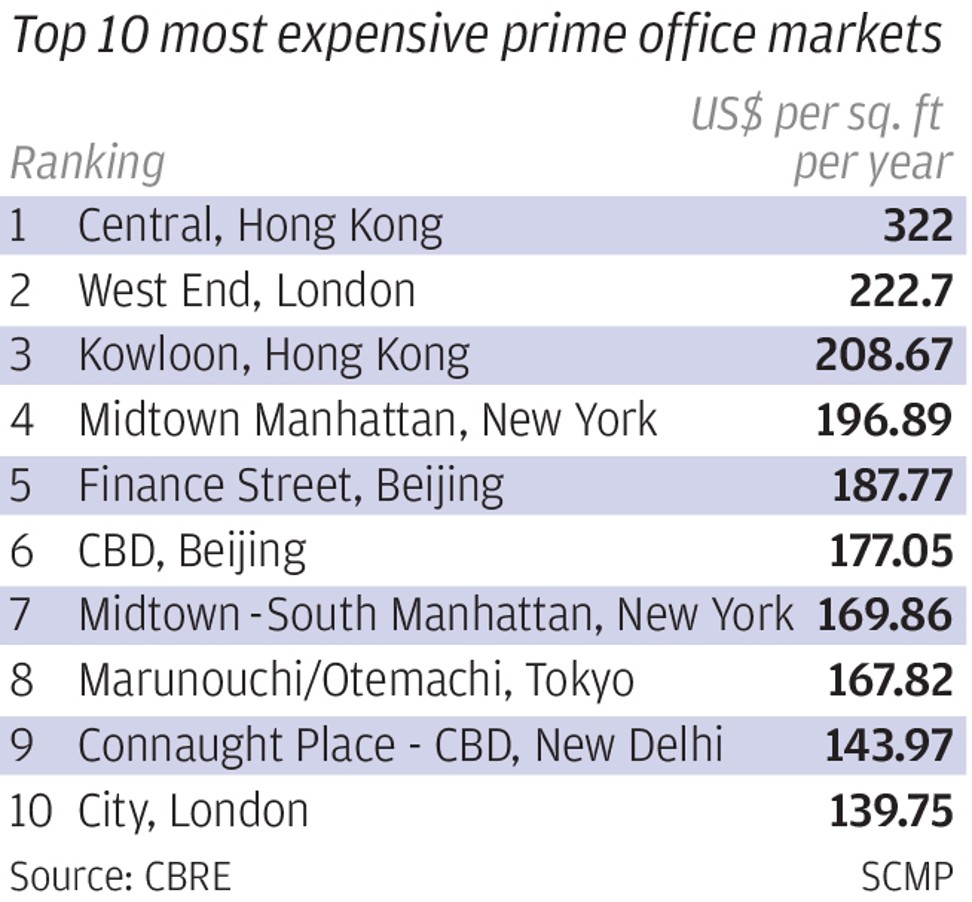
Prime Hong Kong office rents are most expensive globally for fourth straight year, CBRE says
- Office rents in Central and Kowloon have gone up by 5.1 per cent and 10.1 per cent, respectively
- Beijing’s Finance Street and Central Business District both saw 0 per cent growth in rents
Prime office rents in Hong Kong’s Central district are the most expensive globally for a fourth straight year, with growth in rents across Asia doubling year on year, US commercial real estate services and investment firm CBRE said in a report on Tuesday.
Currently, six of the 10 most expensive office markets are in Asia, and rental growth in the region has almost doubled year on year to 3.3 per cent.
The average annual rent for a prime office in Central, inclusive of taxes and fees, rose to US$322 per square foot, about 45 per cent more than London’s West End, which came in second at US$222.7 per square foot. This was the largest difference between any two rankings in the top 10.
“The shortage of new supply and strong demand from financial institutions and mainland [Chinese] companies in the past couple of years are fundamentally” the reasons for the high prices, said John Siu, managing director in Hong Kong at real estate services company Cushman & Wakefield.
Hong Kong’s Kowloon district, with an average annual prime office rent of US$208.67, overtook Beijing’s Finance Street to come in as the third most expensive office market.
Working-class neighbourhood joins the road to prosperity
Office rents in Central and Kowloon grew 5.1 per cent and 10.1 per cent, respectively, from the year before, ahead of the Asia-Pacific average growth rate of 3.3 per cent.
“While Central has long been a premier office location, occupiers are now presented with many other cost-effective options in the city,” said Alan Lok, executive director at CBRE.
Kowloon East and Hong Kong East are two of the most popular destinations for offices relocating from Hong Kong’s main business districts, according to CBRE. Part of the reason is lower rents, which are on average 25 per cent and 40 per cent of those charged in Central, respectively, Lok said.
“New office buildings in Kowloon East, such as Two Harbour Square and Quayside [in Kwun Tong], have also attracted global financial services firms such as DBS and JPMorgan to take substantial office spaces,” Lok added.
“The vacancy rate in the overall market has yet to go above 5 per cent since the end of the first quarter last year,” said Cathie Chung, senior director of research at JLL Hong Kong. “Thus, rents have room to increase … due to limited supply in major office submarkets, with Kowloon East as the only exception.”
Companies pulling back on expanding or moving offices in Hong Kong
Despite fears over the US-China trade war and weaker economic growth globally in the first quarter, prime office rents have increased by 3.6 per cent worldwide, significantly higher than a previous forecast of 2 per cent by CBRE.
Bucking the trend were Beijing’s Finance Street and Central Business District, which saw 0 per cent growth in prime office rent prices. They came in at fifth and sixth places, respectively, falling one and two spots from the year before.
Moreover, CBRE said it expected average prime office rents in Asia to get more expensive in the coming months.
Office rents in Hong Kong’s Central district to fall by up to 7 per cent
“As corporations continue to look to attract and retain talent by securing office environments of the highest quality, we expect this momentum to carry over into 2020 despite macroeconomic and geopolitical headwinds,” said Ada Choi, CBRE’s head of occupier research Asia-Pacific.
Canada-based commercial real-estate services company Colliers International was, however, less optimistic about Hong Kong’s prime office rent getting more expensive. It said it saw “a slowdown in demand in the past six months, which has led to a softening in rent growth”.
David Wood, senior director at Colliers International, said: “Despite limited new supply and historically low vacancy rates, prime central business district rent growth has slowed through 2019 due to general economic uncertainties.
“Transactions volumes have contracted as firms adopt a more cautious approach – a trend we expect to continue over the near term.”
Singapore was Asia’s biggest gainer, with annual prime office rents growing 17.3 per cent year on year to US$114.28 per square foot, which the report noted came “despite recent stabilisation”. Jakarta in Indonesia had the region’s largest decline, falling 7.3 per cent to US$47.79.


